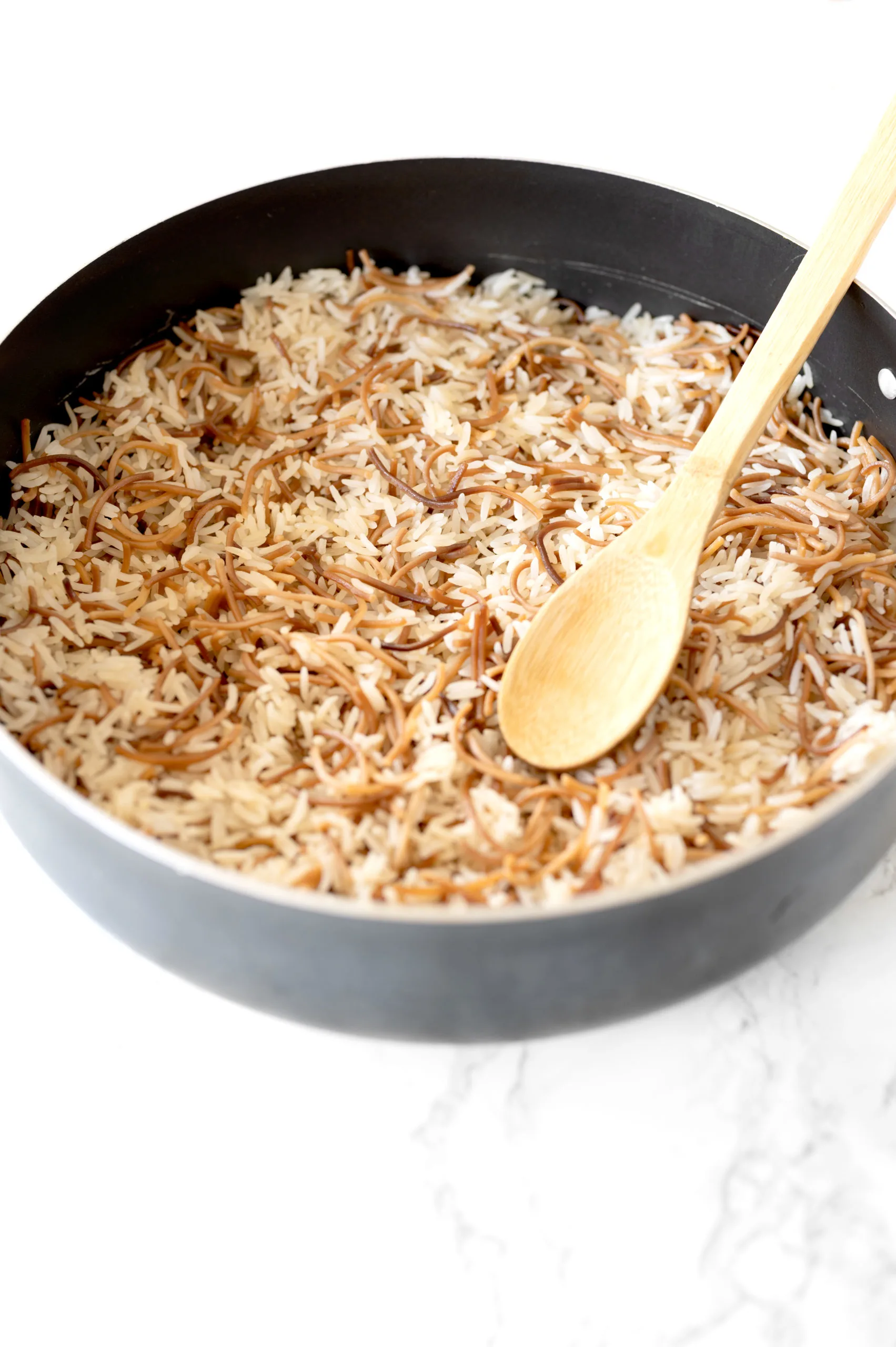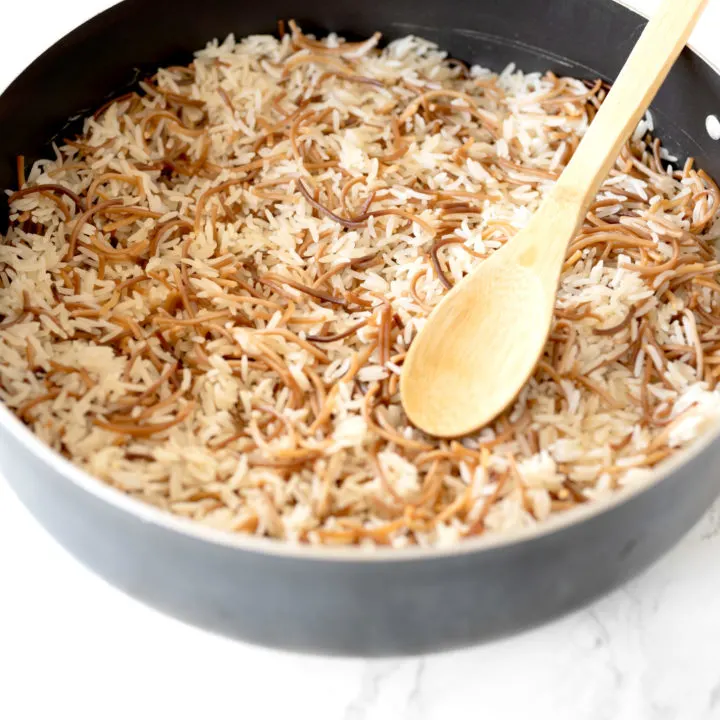Lebanese Rice Vermicelli is a popular side dish in the Middle East and is a nice way to make your rice look special.
This rice, like many Middle Eastern dishes, such as shawarma and hummus, is popular in a number of Middle Eastern countries, and its country of origin is unclear.
While this rice vermicelli is often attributed to Lebanon, I've also seen it called Egyptian.
In any case, I've eaten this and enjoyed it rice Israel and Israeli restaurants, and find it a nice way to bring variety to the table.
It must have come to Israeli through some of it's very many immigrants from other Middle Eastern countries, like so many delicious dishes in Israel have.

If you like this Lebanese Rice Vermicelli, you may also like my Lebanese Beef and Green Beans or my Israeli Rice.
WHY SORT RICE
Sorting rice is useful because I’ve actually found bugs in rice before, especially with already opened bags of rice.
To be sure the rice is clean, measure out how much rice you need, then pour some of it out onto a white plate.
Sift through the rice to make sure there are no bugs – some of which look like small worms.
When done, pour the sorted rice into a pot and repeat with the remaining rice.
As a secondary step, I then fill the pot with water and agitate the rice with my fingers. This helps get anything that may have been missed to float to the top.
Pour out the water, and if you found anything, repeat until nothing comes up.
HOW TO STORE DRY RICE
Store the remaining dry rice by placing it in an airtight container or a resealable plastic bag. Keep it in a cool, dark place.
Doing so will protect the rice from bugs.
I always check the rice before using it even when it is stored well, just in case.
WHY WASH RICE
There are three benefits to rinsing rice.
Firstly, it removes any debris.
Secondly, it removes surface starch. If the starch is not removed, it can cause the rice to clump together and get gummy as it cooks.
Thirdly, if there are any bugs in the rice that weren't caught, they will float to the surface while being washed.
Some say to rinse the rice repeatedly until the water runs clear. This isn’t necessary.
Instead, rinse the rice thoroughly a few times. After that, most of the starch should be removed and the water should be only slightly cloudy.
The way I like to wash rice is by putting it in a large bowl or a pot and filling it with water. Then, I shape my hand into a claw and use it to agitate the rice.
This brings up both debris and bugs that may have been missed during sorting.
WHY TOAST RICE
Toasting rice is a step some recipes require where you first lightly fry the uncooked rice. This step is usually done with rice that has not been rinsed.
As with toasting spices and nuts, toasting grains before cooking can enhance their flavor.
Rice is no exception, as it gains a nutty depth which adds an extra layer of flavor to a final dish.
Another benefit is that by toasting the rice first, you are cooking the starches.
This, like washing rice, helps prevent the rice from being sticky. Instead, each grain cooks separately.
HOW TO STORE RICE
Transfer the cooled, cooked rice into an airtight storage container or a resealable plastic bag. Make sure to remove as much air from the bag as possible before sealing it.
Store in the refrigerator for 3 to 5 days.
HOW TO FREEZE RICE
Transfer the cooled, cooked rice into a resealable freezer bag, making sure to remove as much air from the bag as possible before sealing.
Store for up to 6 months. After that, it is still safe to eat, but the quality begins to degrade.
REHEATING RICE
FROM THE FRIDGE
When reheating, place the rice in a pot, sprinkle a teaspoon of water over the top to help loosen stuck, dried grains, then place.
Heat over medium heat, stirring constantly to keep the grains moving, but be careful not to mash them.
FROM FREEZER
Frozen grains can be added directly to hot dishes like stir-fries. If you’re planning on eating it on its own, follow the steps above.
Tip
It is very easy to over cook the vermicelli. In fact, vermicelli can go from perfect to over cooked in less than a minute. Sometimes mine comes out a little darker than ideal, but that's okay.
However, if you burn the vermicelli, make sure to throw it out and start over.
Lebanese Rice Vermicelli

Lebanese Rice Vermicelli is a popular side dish in the Middle East and is a nice way to make your rice look special.
Ingredients
- 2 cups jasmine or basmati rice
- 2 ½ tablespoons olive oil
- 1 cup vermicelli pasta
- 1 teaspoon salt
- 3 ½ cups of water
- ½ cup toasted pine nuts, optional
Instructions
- Rinse the rice well and place it in a medium bowl and cover with water. Soak for 15 to 20 minutes. Drain well.
- In a medium non-stick cooking pot, heat the olive oil on medium-high. Add the vermicelli and stir continuously for about 3-5 minutes until the vermicelli is golden brown.
- Add the rice and continue stirring until the rice is well-coated with olive oil.
- Add salt and ½ cups of water and bring it to a boil and reduce to a simmer. Cook for 15 to 20 minutes.
- Once fully cooked, turn the heat off let sit for 10-15 minutes.
- Uncover and fluff with a fork. Then transfer to a serving dish and top with the toasted pine nuts if desired.
Nutrition Information:
Yield:
6Serving Size:
1Amount Per Serving: Calories: 231Total Fat: 14gSaturated Fat: 1gTrans Fat: 0gUnsaturated Fat: 11gCholesterol: 0mgSodium: 359mgCarbohydrates: 24gFiber: 1gSugar: 1gProtein: 4g